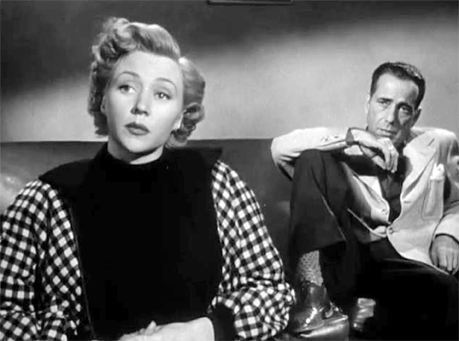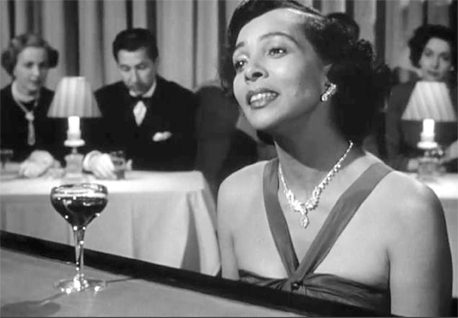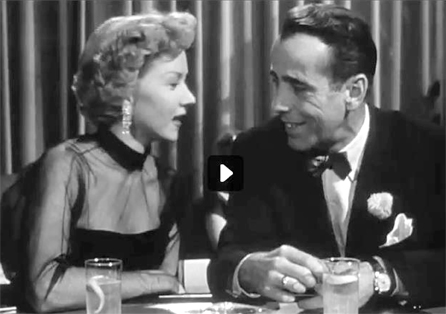
 Laurel is interviewed at the police station after Dix told the police his new neighbor saw the young woman he is suspected of murdering leave his apartment.
Laurel is interviewed at the police station after Dix told the police his new neighbor saw the young woman he is suspected of murdering leave his apartment.
2013 TCM "Summer Under The Stars" Blogathon
Hosted by: Sittin On A Backyard Fence, http://sittinonabackyardfence.com/ and Scribehard on Films, http://scribehardonfilm.wordpress.com/
In A Lonely Place, shown on TCM Thursday, August 1, 5:00 p.m. CST
Posted by Mary McCord, Editor, classicfilmwatch.com
In a Lonely Place, a 1950 film noir, stars Humphrey Bogart as Dixon “Dix” Steele, a hard-edged, struggling screenwriter, who becomes suspected of murder and who writes about love as one who is familiar with love lost. From the beginning, it is evident that Dix suffers from some kind of personality disorder or at least a serious anger management issue exacerbated by alcoholism. This is evident even in the first scene when he stops at a traffic light and ends up having angry words with the motorist in the next lane. The movie is a different kind of film noir, a combination of dark thriller, romance and drama and this, along with Bogart’s fine, believable performance, is what makes it memorable.
Gloria Grahame co-stars as Laurel Gray, a neighbor and aspiring actress who looks at Dixon through rose-colored glasses in the beginning, ignoring his angry outbursts fueled by his alcoholism. She manages to see beyond his exterior behavior because of her attraction to him—one that even she doesn’t understand. That is until the rose tint gradually fades into darkness as she witnesses such violent behavior that she begins to fear Dixon and suspect him of the murder he is accused of committing.
Nicholas Ray directed the film that was produced for Bogart’s own Santana Productions. Ray’s direction etched a complex emotional portrait of a man tormented, who exists in a lonely place. When he tries to come out into the open, his angry, violent behavior alienates his friends and love interests, thereby increasing his aloneness. To complicate matters even further, he leads the lonely life of a writer, a job that he has to do solo.
Ray used many different devices in the telling of the story. In a happy scene, where Dix and Laurel go to a nightclub, the performer (Haddas Brooks) sings softly the lyrics, “I was a lonely one till you…” reinforcing the theme. Ray ditched the movie’s original ending that was a more predictable film noir resolution and elected to reveal more of the internal workings of the characters. This decision culminated not in a clever, twisting ending, but in an extremely suspenseful ending that moves the heart.
Andrew Solt developed the screenplay with input from Ray and Robert Lord, the producer. The movie is based on the 1947 novel, In a Lonely Place, by Dorothy B. Hughes, but the script does not follow the book and is actually a different story. Even the Dixon character is in name only in the film and is depicted with great differences in values and motivations than the novel’s Dixon, who is a psychotic stalker of women. Solt gives Bogart some great lines, the kind that sound like they should come out of Humphrey Bogart’s mouth. For example, when the chief of detectives interviewed him about the murder, he told Dix that his attitude was puzzling that he didn’t seem to be that concerned and had only a couple of feeble jokes. “I grant you the jokes could have been better, but I don’t see how the rest should worry you. That is, unless you plan to arrest me for lack of emotion,” Dix retorted.
The film begins with Dix meeting his agent at a nightclub where they discuss the adaptation of a book for a movie. During this conversation, Dix manages to mix it up with a man who is insulting an actor friend of his. The book to be adapted had been left earlier for Dix with the hat-check girl, Mildred Atkinson, played by Martha Stewart. She had been reading the book and finished by the time Dix was ready to leave the nightclub. Dix, who says he is too tired to read the novel, convinces Mildred to go home with him to tell him the story.
In the courtyard of his apartment building, they pass Laurel, who is a new tenant. Mildred gives Dix the details of the book, confirming what Dix had suspected -- the book is a trashy bestseller. He is not excited about the writing project, pays Mildred for her help and tells her to take a cab home. Later that night, Mildred is murdered and Dix is the prime suspect, having seen her last. Also, the police know of his reputation for being angry, sometimes violent. His peculiar sense of humor doesn’t help him any either. Fortunately, his new neighbor, Laurel, tells the police that she saw Mildred leave Dixon’s apartment the night she was murdered, giving him an alibi.
Soon, Dixon and Laurel become romantically involved. Dixon is inspired to write again, sometimes pulling all-nighters. Laurel is understanding and thoroughly in love and shows this by typing his manuscript, cooking his meals and helping with anything else he needs so that he can devote himself to his work. But it isn’t long before Dixon returns to his previous angry behavior. And Laurel’s understanding slowly melts into fear. She begins to wonder if he did commit the murder. Her suspicion, doubts and fear lead to insomnia.
At a beach party, Dix becomes angry when he discovers the police had talked to Laurel again and she hadn’t told him. On leaving, Dix furiously drives at high speed with Laurel in the car and ends up sideswiping another car. The other driver is belligerent. In the ensuing struggle, Dix beats the man unconscious and is about to strike him with a large rock, but Laurel stops him.
Later, when he has calmed down some, he quotes Laurel some lines he has written for the script he is working on that foreshadows events to come: “I was born when she kissed me; I died when she left me; I lived a few weeks while she loved me.” Dix proposes marriage and Laurel accepts because she is afraid of what would happen if she refused.
A sense of fatalism is present throughout the story, even at the height of the love affair. As with some of the best film noirs, you’ll wish the ending were different. You’ll find little that is uplifting about the dark movie. The only thing that might be raised in watching it is your emotional IQ. And that’s the brilliance of In a Lonely Place.
Note: If you would like to see more photos, click the Facebook icon to visit Classic Film Watch's Facebook page. Thanks for your interest!
Note: All photos are screenshots from the trailer for In A Lonely Place that was not copyrighted.

Dix gets a crazed look on his face when he encourages his friend, one of the detectives investigating him, to strangle his wife during a re-enactment of the crime.

Bogart rages...Bogart loves... in the emotional film noir, In A Lonely Place
 On a happy evening when Dix and Laurel were in a nightclub, a singer (Hadda Brooks) sang the lyrics "I was a lonely one til I met you . . . ", from a poignant tune that reinforced the theme of the film and relationship of the pair. Hadda Brooks was a pianist, vocalist and composer who is known for singing at Hawaii's official statehood ceremony in 1959 and being the first African-American woman to host her own television show in 1957.
On a happy evening when Dix and Laurel were in a nightclub, a singer (Hadda Brooks) sang the lyrics "I was a lonely one til I met you . . . ", from a poignant tune that reinforced the theme of the film and relationship of the pair. Hadda Brooks was a pianist, vocalist and composer who is known for singing at Hawaii's official statehood ceremony in 1959 and being the first African-American woman to host her own television show in 1957.
 Laurel and Dix enjoy an evening out, but their times together were not always so happy.
Laurel and Dix enjoy an evening out, but their times together were not always so happy.

Believe it or not, this is a love scene. Their relationship was very intense.
